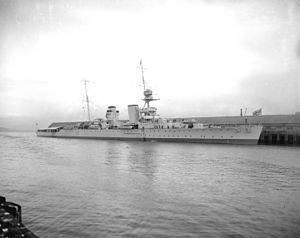Name Raleigh Ordered 12 December 1915 Commissioned 1921 Construction started 9 December 1915 Length 184 m | Laid down 9 December 1915 Struck 1926 Launched 28 August 1919 | |
 | ||
Builder William Beard and Company | ||
HMS Raleigh was a Hawkins-class heavy cruiser of the Royal Navy. She was commissioned as part of the British North Atlantic squadron in 1921. Within in a year of commissioning the ship was paid off after having run aground off Labrador. The vessel was eventually destroyed with explosives in 1926.
Contents
Design
She had a full load displacement of 12,000 long tons (12,000 t) (light, 9,700 long tons (9,900 t)), an overall length of 605 ft (184 m), and carried a complement of 700 officers and men. She was the only ship of the Hawkins-class to be completed with 70,000 shp (52,000 kW) machinery; on trials off Isle of Arran from 7–9 September 1920, she reached her designed speed of 31 kn (36 mph; 57 km/h) at full power of 71,350 shp (53,210 kW). At half power, 35,000 shp (26,000 kW), she still managed to make 28 kn (32 mph; 52 km/h). After trials the ship proceeded to Devonport for completion as a flagship.
Service history
In April 1922, Sir William Christopher Pakenham was Admiral of the Royal Navy's North America and West Indies Station and he designated Raleigh as his flagship. Sir Arthur Bromley was the captain of Raleigh and it was through his negligence that the ship was lost. On 8 August 1922, Captain Bromley sped the flagship through thick fog and ran her aground at L'Anse Amour, Newfoundland and Labrador. Eleven sailors were drowned in the shipwreck.
The ship remained hard aground and upright for four years. During this period, she was paid off and stripped of all salvageable items and was then destroyed with explosives by HMS Durban in September 1926.
The residents of L'Anse Amour conduct an annual re-enactment of the event on the anniversary of the disaster.
